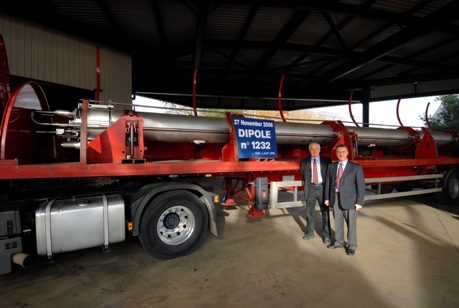
Delivery of the last superconducting dipole for the LHC on 27 November.

Things are getting real and the first serious in situ tests of the installed magnets have taken place. Inevitably there are some problems...
During the pressure test of sector 7-8 on November 24/25, the inner
triplet left of 8 failed at a differential pressure of 9 bar (compared to an
operational peak of over 20 bar). This has now been traced to the external
heat exchanger, which ruptured near the end (image
1 image 2 image
3). What is now
clear is that this is NOT a one off, but rather a design error which affects
all
inner triplet magnets. They will all need intervention, and 18 of the 24 are
already in the machine. If the problem is restricted to the ends of the heat
exchanger, it may be possible to fix them in-situ. This will be easier in some
places (around point 8) than others (around point 5). Furthermore, before anything
is done, a comprehensive pressure test (test to destruction) will be made on
a triplet heat exchanger to ensure the integrity of the whole; if this does
not pass a given pressure, all the magnets will have to come out. This test
is foreseen for this week.
After these problems occurred in November, the rest of sector 7-8 successfully
passed the pressure test. Subsequently the sector underwent preparation for
cool down. During the ELQA, a new problem occurred. During the high voltage
tests, a short appeared, at a voltage of around 100V compared to operational
peak of some 1kV. This short has now been localised to the ~1m level, and the
section will be opened today. Hopefully it is on an interconnect and can be
fixed in situ.
A summary of what's going on on the installation front is shown below (c/o Sylvain Weisz).
The main points;
• The cryogenic supply line (QRL) will be complete by the end of October
• With interconnection in progress in sector 3-4, 4 sectors are ongoing in
parallel
• The cryostat in sector 4-5 will be closed mid January
• Interconnection in sector 5-6 starts mid November
• All cold elements of sector 7-8 are in place
• 809 main bending dipoles (total 1232), 236 arc short straight section (SSS -
the quadrupoles - total 392) and 54 Special SSS (insertion quadrupoles) are now
in place
• Short circuit tests of the LHC power converters are about 50% complete
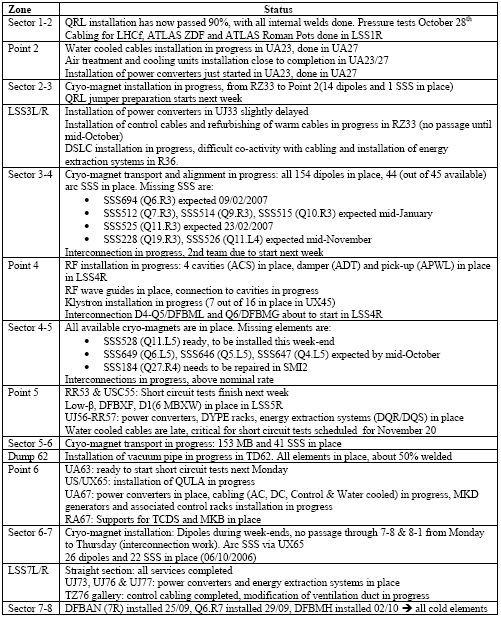
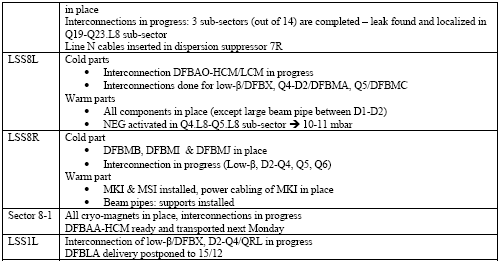
His lectures are available at the following web link:
* ‘Exceptional CERN Colloquium (completely packed auditorium) - The Origin
of the Universe’ (for a general audience): here [video]
* ‘The Semi-Classical birth of the Universe’ (for a specialist audience): here [transparencies
& video]
It's the dog days of the summer, lots of people away on holidays. The number of meetings has dropped, happily, to almost nothing. Work continues steadily in the tunnel with more than half the total number of magnets now being underground. Magnet transport is off the critical path and the spotlight turns to the challenge of joining, or interconnecting, the magnets. This complex, painstaking work, involving vacuum, cryogenics and all the cables and bus-bars which carry the current to the many magnet circuits.
Inevitable delays have accumulated and a new schedule has recently been published (See here (zoom in to make any sense of it)). The aim is collide beams at the injection energy of the LHC (450 GeV) at the end of 2007.
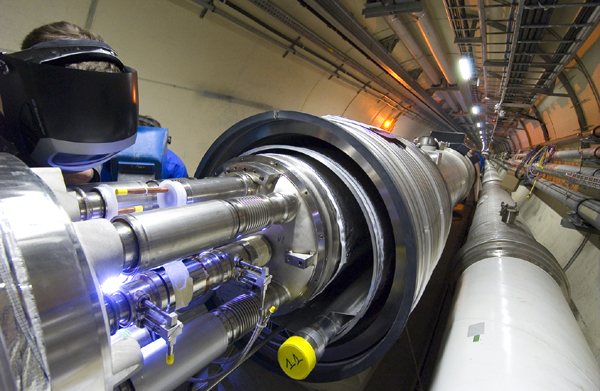
Rather idealised picture of interconnect work in progress.
While the LHC is being installed, the rest of the accelerator complex keeps turning. The SPS is, among other things, performing the first tests of CNGS which aims to send lots of neutrinos to Italy. Long, hot summers can cause hardware problems, and this year has seen a few. For example: in the latest in the growing list of problems, the PS Injection septum SHM42 has failed with the symptoms being a strong vacuum rise during pulsing. This afternoon the experts went in and checked the magnet. After the first series of tests the presently most likely assumption is internal sparking. Since the septum is radioactive and repair of an unknown fault would take time - and still require breaking the vacuum - it has been decided to replace the septum with the spare. Pictures here and here.
Kickers and Septa installed in point 8!
The first two LHC collimators from the CERCA/AREVA series production have today been installed into the LHC tunnel at IR8R. Both collimators are in the LHC tunnel but are active on the transfer line, protecting the LHC against wrong injection pulses. Next week two more collimators should be installed in IR8R and IR8L, including one ring collimator for triplet cleaning and protection. c/o Ralph Assmann
P.S. Another 80 collimators to be installed before start-up...
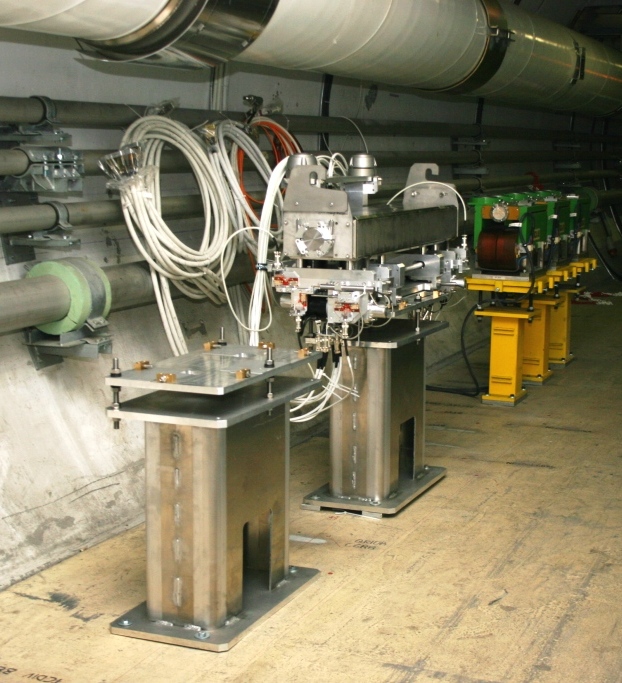
Busy time of the year. We're cranking up the accelerator complex (PS, SPS etc. etc) after a year off. This from the new CERN Control Centre. The Control Centre brings together all operations for the first time. This includes technical services, cryogenics, and all accelerators. A big space is reserved for the LHC.

At the same time, of course, installation of the LHC is frantically taking place all around the 27 km. It's difficult to get a idea of the full scale of activities but just as a very brief summay...
Sector |
Status/Main activity |
1-2 |
Preparation |
2-3 |
Cryogenic supply line installation |
3-4 |
Cryogenic supply line finished, preparation for magnets |
4-5 |
Magnet installation, quench protection/cryo instrumentation |
5-6 |
Finishing cryogenic supply line installation |
6-7 |
Cryogenic supply line installation |
7-8 |
Most magnets in place - interconnection in progress - vacuum tests etc. etc. |
8-1 |
Most magnets in place - interconnection in progress - vacuum tests etc. etc. |
For various reasons, including an LHC machine workshop, there are quite a few Americans in town. The States are heavily involved in the LHC experiments and have also built some of the critical components for the accelerator, some of which have just been installed in the tunnel. If they do the relevant saftey courses they can go down and have a look... inner triplet magnets et al point 8
It's Machine Advisory Committee week. A bunch of wise men and women who know a thing or two about accelerators turn up to review progress. Cue a few presentations in open session, some in closed session and maybe some more serious stuff behind closed doors. The progress report from the LHC project leader, echoed by the feeling you get down in the tunnel, shows that things are suddenly starting to look surprisingly concrete. This reveals a curious CERN phenomenon: the ability to resolve problems and the ability to recover from the effects of these, sometimes, very time consuming issues. This goes hand in hand with a remarkable commitment in some areas.
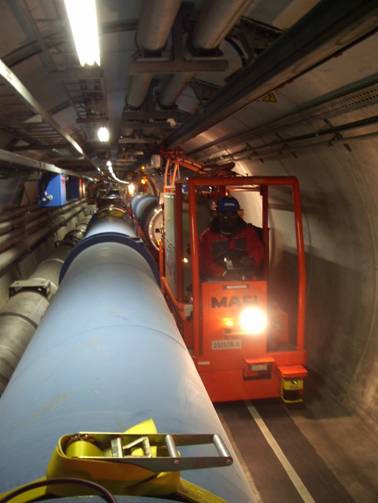 |
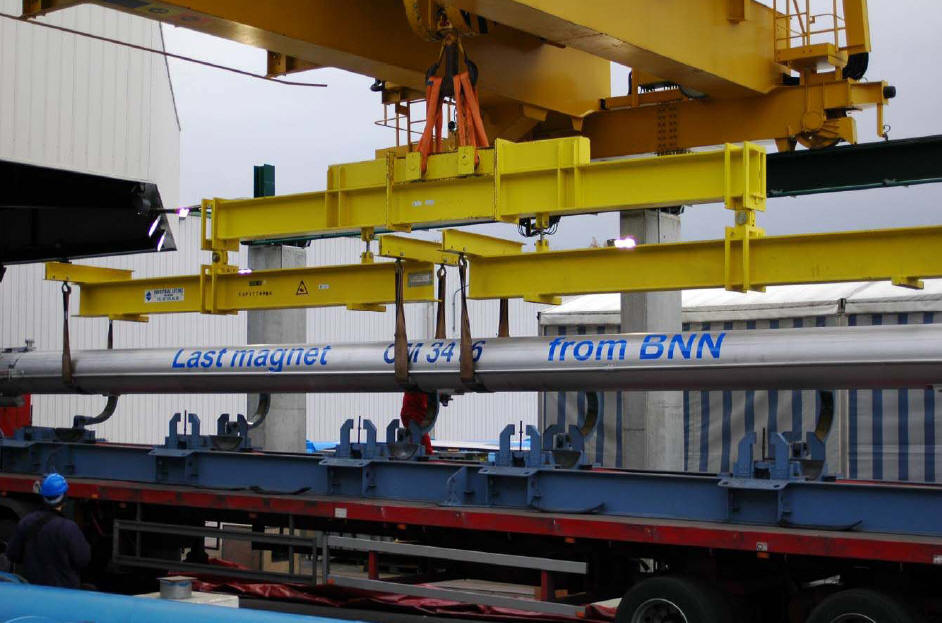 |
Things change quickly. Over in the SM18 control room where they drive and monitor the testing and measurement of the main dipoles and quadrupoles - a colleague on shift there was rather nonchalantly ramping a dipole to its ultimate current of 12850 Amps. A routine event after something like 900 dipole magnets but a couple of years ago this have warranted at least a bottle of champagne. The magnet is kept at this current for around 10 minutes. We then wandered down into the test hall, the data acquisition system is primed and the circuit is discharged. The quench heaters are then fired to warm the magnet up. Job done.
Power converter tests ongoing in point 8. The ones that drive the main bends & quads have been taken up to nominal current (around 11,000 Amps).
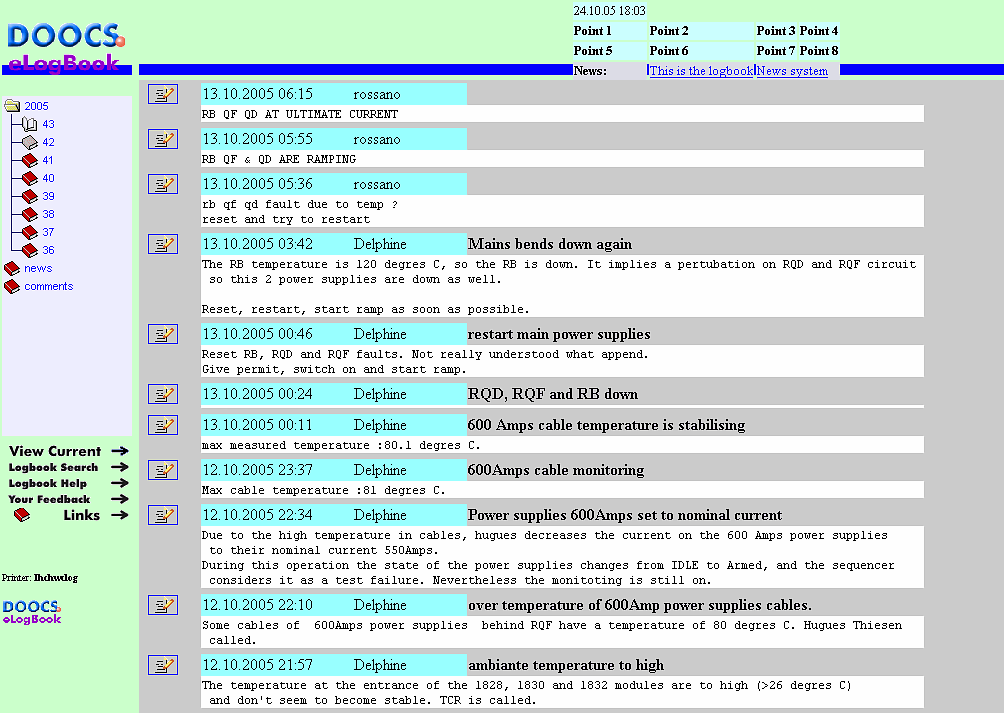
Back down to point 8 and hardware commissioning is in progress - essentially short circuit tests of the power converters. Just along the tunnel in sector 78, 600 metres of the QRL is cold - special access conditions in place. Photos here
It's CERN council week, during which the governmental representatives of the members states turn up for a high level progress report and to formally approve the budget.
Happily, and coincidently, the first subsectors of the cryogenic supply line (or QRL as it's known at CERN) have been cooled in sector 7-8. The QRL runs along side the magnets in the tunnel and supplies the liquid helium necessary to get the super conducting magnets down to 1.9 K. There were some small problems during a pressure test before the cool down attempt but these were resolved quickly and thereafter things went well. The QRLs have proved somewhat problematic; this is good news.
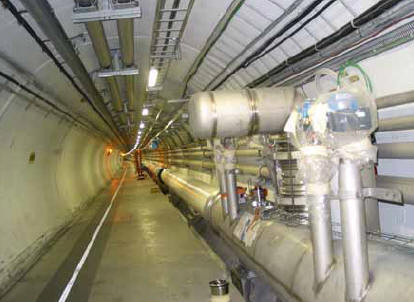 QRL (without magnets)
QRL (without magnets)Important milestones have been successfully reached today in the installation of the two largest magnets ever built for experiments at CERN. At one side of the 27 km ring of the future Large Hadron Collider (LHC), the 230 tonne solenoid magnet for the CMS experiment has been rotated through 90° prior to insertion into its cryostat – the jacket that will cool the magnet to 4.2 K (-269° C). At the opposite side of the ring, in the underground cavern where the ATLAS detector is being constructed, the last of eight 25-m long toroid magnet coils has been put into place, to complete a huge magnetic “barrel” that forms a major part of the detector.
Successful tests of the around 30 or so power converters (out of a total of 1700) in point 8. These were short circuit tests - later in the year the converters will be connected to magnets to be installed around point 8.
Just been down in point 8 on a Monday morning - a lot busier in the tunnel than on a Friday afternoon - the cryogenic supply line has extended in the straight sections either side of LHCb, power converters are in place, and there's a very basic field control room in place for the power converter tests. Starting to feel real down there.
30+ dipoles are in place in the tunnel in sector 81. Some interconnection work has started. However, some slight delays to a problem with the service modules of the cryogenics supply lines. Intervention required to fix problem.
Over half the 1232 dipoles needed for the complete 27 km. have been delivered - a pretty incredible milestone. The magnets are installed in big blue cryostats about 15 m. long, and given the installation delays, the finished articles are being stacked up around CERN in every available location.

Press release
! Photos ! : please see online -
http://info.web.cern.ch/Press/PressReleases/Releases2005/PR02.05E1er-aimant.html
LHC magnets: the great descent
The first superconducting magnet for the Large Hadron Collider (LHC) was lowered into the accelerator tunnel at 2.00 p.m. on Monday, 7th March. This is the first of the 1232 dipole magnets for the future collider, which measures 27 km in circumference and is scheduled to be commissioned in 2007. The date was thus a key one for CERN since the delivery of the 15 metre long dipole magnet weighing 35 tonnes to its final location marks the start of LHC installation.
The LHC will consist predominantly of superconducting dipole magnets, which are the most complex components of the machine. Their superconducting coil allows them to convey extremely high currents without any loss of energy. They are therefore able to produce very high magnetic fields in order to bend the trajectory of the protons that are accelerated at a speed close to the speed of light. The LHC will thus be the world's most powerful accelerator. The collisions between the protons will reach energies of 14 teraelectronvolts (TeV), 70 times higher than those of the former LEP collider for which the 27 km tunnel was originally built. To reach the superconducting state, the magnets have to be cooled to a temperature of -271°C, close to absolute zero. If the LHC had been made of conventional magnets, it would have needed to be 120 km long to achieve the same energies and its electricity consumption would have been phenomenal.
These superconducting magnets will all be lowered 50 metres down below the
earth's surface via a specially made shaft of oval cross-section. They will then
be conveyed through a transfer tunnel to the LHC tunnel, which lies at a depth
varying between 50 and 150 metres. Vehicles travelling at 3 km an hour have been
specially designed to deliver the magnets to their final destination. The
narrowness of the tunnel complicates these handling operations, making it
impossible, for example, for two loads to pass each other.
In addition to the dipole magnets, the LHC will be equipped with hundreds of other, smaller magnets. More than 1800 magnet assemblies will have to be installed. Once in position, the magnets will be connected to the cryogenic system to form a large string operating in superfluid helium, which will maintain the accelerator at a temperature close to absolute zero.
The lowering of this first magnet into the tunnel coincides with another milestone for CERN, namely completion of the delivery of half the superconducting dipole magnets. A total of 616 magnets have been delivered to date, and the same number are due to arrive by autumn 2006. The manufacture of these superconducting magnets represents a huge technical and industrial challenge both for CERN and for European industry. 7000 kilometres of niobium-titanium superconducting cable have had to be produced to make them. Around a hundred companies in Europe are manufacturing the magnet components, and three companies, Babcock Noell Nuclear in Germany, Alstom in France, and Ansaldo in Italy, are responsible for their assembly. The greatest challenge was the move from the prototyping and pre-series phase to large-scale series production, which involved much ground-breaking technology. Success has been achieved, with three industrial sites now able to manufacture between nine and ten magnets a week.
25th February 2005
A milestone has been met today: The first repaired service module of sector 7-8 is back on its brand new supports. [c/o Claude Hauviller]